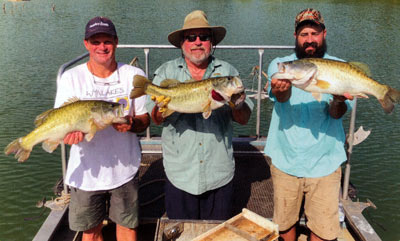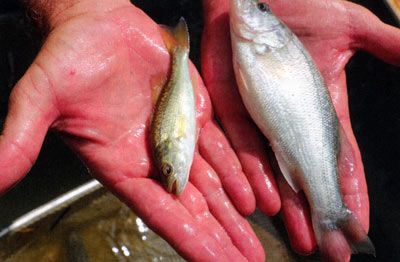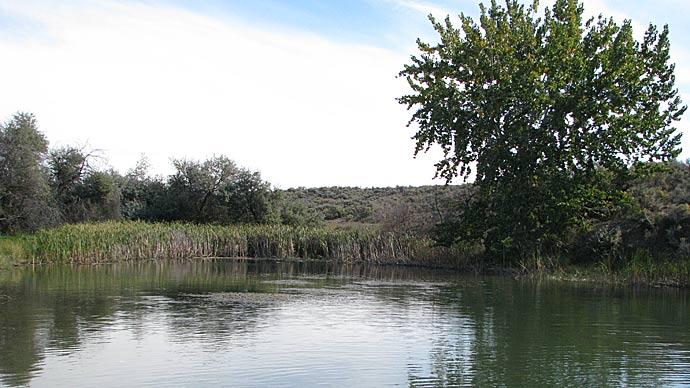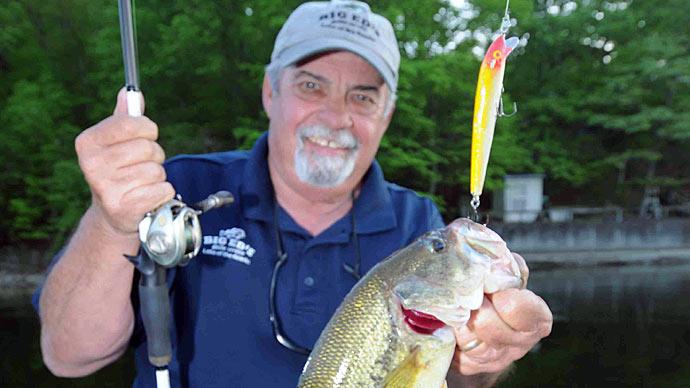
Recently on the Pond Boss discussion forum, someone asked the following question: 7 need help deciding if this stocking plan will be successful. We have a 50+ acre lake in the Florida panhandle ready to stock in the next few months. Obviously, it will take a significant amount of fish and money to get it going. Here is the question, 'If we put 24,000 fingerling Coppernose bluegill and 24,000 Fathead minnows, left it alone for a year, and then come back with 60 Largemouth bass/acre would this stocking plan be successful for a bass fishing lake?' I would probably come back during the year and also put a load of Threadfin shad in as well. My thoughts are with no predators the bait could really multiply in a year's time. One drawback I have been told was that by doing this it gives the Coppernose bluegill time to mature enough to be able to eat the fingerling bass when they are stocked? Also, in the equation we will be adding a couple feeders to help the bluegills grow. I do have plans as well to start a hatchery pond to supplement the bream and or Threadfin shad. Any and all advice is welcomed, just want to get this one going in the right direction from the start and not have to play catch up with time or money."
When a lake is properly stocked in the beginning, and with a sound strategy, the results are normally predictable, but how do ponds try to balance themselves in response to our management attempts? Nature can always derail the best-laid plan with weather, too much plant life, an invasion of predators, a bad algae bloom—there's a long list of influences.
But, aside from unpredictable derailments, here's what to expect from this stocking plan. Let's dissect it and I'll share what to expect, broken down into five years.
Year One, forage fish are stocked with 24,000 fathead minnows and 24,000 bluegills. That's about 3-4 pounds of fatheads per acre. In the first six months, with fertility in the water and plenty of spawning substrate, the lake will produce about 15 pounds of minnows per acre. It should max out around 40-60 pounds of fatheads per acre and sustain there as carrying capacity dictates. Parallel to minnow production, some of those small bluegills will grow to 3-4", stop growing, and focus on reproduction. That will take about two months. At that point, you'll see quite a few spawning beds, with anywhere from 20-200 little craters of small bluegills reproducing. When the babies come off the nest, they'll compete with fathead minnows. They'll eat some small minnows, too. The bluegills will spawn in cycles most of the summer in this southern lake.

Within those same six months there'll be a sharp increase in tiny bluegills, and overall growth rates of bluegills will level off. Around the feeders, some of the bluegills will push well beyond six inches that first year. Those will become the dominant spawners by fall. As Year One progresses, I would expect a food chain of 100-150 pounds per acre to develop.
At the beginning of Year Two, when bass fingerlings are stocked, the bass will grow extremely fast. Fingerling bass, 2-3" in size, will find tens of thousands of tiny fathead minnows and small bluegills. Bass that size will feed primarily on small fatheads and insects. Insects will proliferate due to the healthy water and the abundance of fish to eat as well. Bass will go from 2-3" to 6" within six weeks. At that point, their sizes will begin to differentiate. The most aggressive, fastest growing bass (mostly females) will shoot to 8-10" over the next two to three weeks. By fall, the slowest growing bass will be around 8" and the best of the best will be at least two .pounds, maybe bigger. Fathead minnow numbers will begin to decline measurably by fall, and bluegill numbers will continue to rise. Bass poundage will be around 20-35 pounds per acre (in theory), and the food chain will still be high. Productivity of the food chain dynamics will change. As forage fish are being eaten and converted to bass, survival rates of newly-hatched fish will rise. The dynamics of that function will shift, based on how productive the water is. That medium will dictate production. In the phosphate pits of the Florida panhandle, productivity stays high. Jay, Florida, where this pond is, has some productive soils around it, which influence nearby waters. That region of Florida is famous for productivity. So, if the water can encourage the continuance of forage fish spawning, here's what to expect.
As bass grow, bluegill sizes will increase. Bigger bluegills will dominate the spawning beds, and more babies will be cranked out. When bass mass reaches around 50-60 pounds per acre, the forage fish will be approaching maintenance level.
At that point, in Year Three, the biggest bluegills will be 8-9", and those originally stocked bass will range from 10" to six pounds. Of those originally stocked bass, half are boys, and will top out around 14-16". From the other half, the females, you can expect 20-30% to be the biggest, 30-40% to be average, and the rest to be under-performers, passive, and slow-growers.
Here's where it gets fun.
In Year Three, expect those biggest bass, which are now a year old, to reproduce. So, the biggest females will dominate reproduction, which is a good thing genetically. The concern stated above is that there could be so many bluegill eating baby bass as they come off the nest, that recruitment of bass in Year Three could be a problem. That's a problem I'd welcome. That means the lake still has lots of forage fish. If recruitment is inhibited, stock 2,000 bass fingerlings and you've bought the recruitment for the second age class of bass. But my bet is that enough baby bass would survive the onslaught of bluegills to add that second year class.
Electrofish to confirm.
During Year Three, the lake's carrying capacity for bass will begin reaching max. That's when we start looking at culling. More on that in a minute. In Year Three, we expect bass reproduction, and those baby bass fuel the need for culling. So, if bass don't recruit well in Year Three, we can push back culling until Year Four. In the meantime, we now have 6-8 size classes of bluegills, two sizes of those are the primary broodfish/spawners for the entire lake. In the other 4-6 size classes of bluegills, which we assume will grow as fast as possible, we can expect 80-90% of them will be eaten within the first 90 days of their lives. The remaining number offish from each spawn will dwindle over the next 90 days as voracious bass eat them—and all the while the brood fish continue to shower the lake with new babies to take the place of those who gave it up for bass to grow.

As all this is occurring, Threadfin shad are establishing themselves in the open water and beginning to affect bass behavior. As schools of shad push into 2-3", and then 3-4" size classes, intermediate-sized bass will begin to alter their behavior and shift from exclusively littoral inhabitants into part-time chasers of shad in open water. That behavior will influence bluegill behavior. Bluegills will feed more aggressively and not always have to retreat to safety in lieu of feeding. Again, productivity of the water will influence these factors as well. By the end of Year Three, the best of the best bass from the originally stocked group will be 6-7 pounds, maybe one or two bigger. By now, those originally stocked bass will fundamentally be three size classes. The best of the best for that lake will be excitingly huge and pretty hard to catch. That's probably going to be 150 of the originally stocked fish, inhabiting the best habitat for fish that size. The next size class will be 3-5 pounds, and numbers will be around 150-200 of those. Considering attrition, the remaining bass will range from 1-3 pounds and will number 1,000- 1,500 and average around one pound to slightly under two pounds. Attrition comes as the best of the best grow larger and mouth gape increases. When that happens in this scenario, those slow-growing bass become food. Those 6-7-pound bass are now making their primary living off big bluegills and those slow-growing bass. If anyone takes time to do the math, these numbers are now somewhere between 50-75 pounds of bass per acre, which is the amount nature sustains, depending on how fertile and productive the water is at any given time. One other important factor here is the dynamics of the food chain.
During the course of the second, third, and fourth years, if we had a way to measure productivity, we'd see a lake like this producing somewhere around 300-600 pounds of forage fish per acre, per year. But the standing crop would rarely exceed 150 pounds per acre on any given day. That's why it's so important to keep the predator/prey relationships as close to balanced as possible. When the predators overwhelm their prey, productivity of forage fish plummets and carrying capacity for prey becomes dominated by how many mouths there are to eat a baby fish right off the nest.
In Year Four, barring any of those natural influences we can't necessarily predict, expect major changes in the fishery. You have a significant mass of bass beyond 17", and they've spawned. Now, you have an unpredictable number of baby bass decimating the food chain at a lower level. They're eating young bluegills, crawfish, insects, each other, and snakes, snails, and puppy dog tails—whatever dares enter the water. Time to cull. Set your limits based on lengths and weights of your bass. Now is the time to be vigilant about culling. For a 50-acre lake, expect to cull 1,000-1500 small bass per year. That's work. For the remaining fishery, the biggest bass have all they can eat, zeroing in on 8-12" bass and large bluegills for dinner, or, breakfast, or lunch, or snacks. Threadfins are thriving, but their numbers will dwindle during cool months as intermediate-sized bass feed on them heavily. Your biggest bass are knocking on the door of double-digit sizes, and maybe four or five across the lake will hit that magic size in Year Four. During this year, expect forage fish numbers to drop due to heavy pressure from young bass. Catch rates will rise, and anglers will be catching lots of 10-14" bass, with good numbers of 3-5 pounders, a rare 6-8, and maybe a 9. Bluegills will be knocking on the door of 10-11", well beyond a pound, some maybe 1.5 pounds if the feeding program is consistent.
Year Five shows the best potential for young double-digit bass, maybe 10-15 of those across the lake. Bluegills can weigh over two pounds, with lots of bluegills in the 4-6" size class, if bass culling has been consistent. For the next three years, this lake has a great shot at some huge bass, with fun fishing, catching good numbers of 4-6 pounders, with some 8 pounders and an occasional huge fish.
All this is influenced by hurricanes, droughts, flocks of cormorants and pelicans, otters, and freezing weather, which will eradicate your threadfin shad. It's also influenced by quality and quantity of habitat in the lake, as that gives different sizes of different species of fish what they need to thrive. Productivity of the water will be a great influencer as well. Volume and species of plants influence a fishery, too.
Making a workable stocking plan takes some careful thought, and executing the plan based on projected results helps guide a lake toward success. But, the biggest word of caution is to pay attention to the lake over the long term and make sure it's doing what you expect it to do.
If you'll do that as a pond manager, your lake will respond accordingly.
Reprinted with permission from Pond Boss Magazine



